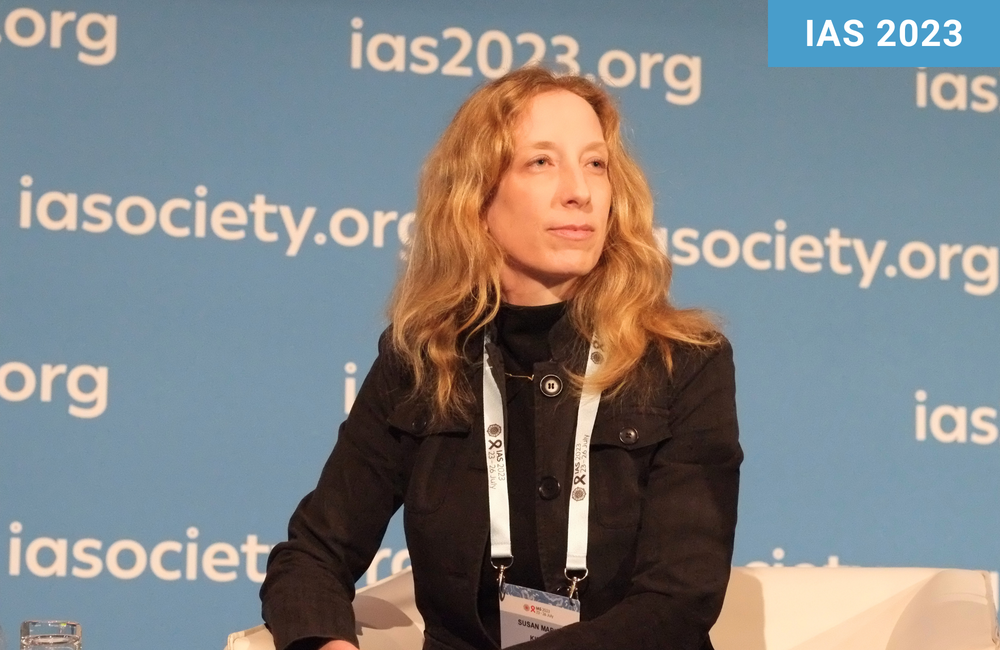
A cluster-randomised study in Uganda that combined home HIV testing with three home-based counselling support sessions and a peer-navigation session in a clinic produced significant increases in the proportion of people who started antiretroviral therapy (ART) and were retained in care over the following year. At the end of the first year, 55% of people in the intervention arm had a viral load below 20 compared with 44% in the control arm.
Dr Susan Kiene of San Diego University in the US and Makerere University in Uganda told the 12th International AIDS Society Conference on HIV Science (IAS 2023) in Brisbane, Australia, this week that the study was specifically designed to support people who, because they receive their HIV test result at home, cannot be given same-day therapy.
Same-day ART has been associated with better linkage to care and viral suppression rates in some studies, though not in others. But leaving people who test HIV positive to link themselves to care without support was shown, from the first community-wide studies of mass testing, to result in long gaps between testing and treatment and poorer outcomes.
The Ekkubo study was designed to smooth the path into care for people who tested HIV positive on a home visit and so could not immediately be clinically assessed or given ART.
The study offered HIV testing in 56 villages in four largely rural districts between November 2015 and March 2020. Community health workers and researchers went door to door in the villages to offer HIV counselling and testing to people aged 18 to 59 in each household. Blood tests including CD4 counts were taken at baseline (before HIV testing), month 6 and month 12. Viral load tests were performed on those testing positive at baseline and at month 12.
The 56 villages were divided into 28 in which people received the intervention and 28 in which they didn’t.
The intervention consisted of three brief counselling and support sessions at diagnosis, after two weeks (when participants received their CD4 results) and after six weeks, plus a navigation session at their first visit to the clinic. The sessions addressed perceived and experienced barriers to care and ways to deal with them, stigma and how to respond to it, social support and navigating the care system, with participants encouraged to create a personal care plan. People who did not link to care were contacted by phone 6 and 12 weeks after diagnosis. The control arm received a written referral to the nearest clinic plus a home visit at two weeks to receive CD4 results.
The total population tested numbered 33,353 individuals, of whom 567 (1.7%) tested HIV positive. Most were newly diagnosed, although the study did find 24 people or just over 4% who had tested before but dropped out of care.
The 567 people were split evenly into 284 receiving the intervention and 283 not. Sixty-two per cent were women and the average age was 31. Although 50% of people were married, significantly more people in the control arm lived with their spouse most of the time, whereas spouses in the intervention arm were often apart. The other significant difference was income, with people in the intervention arm earning $30.46 a month compared to $22.25 a month in the control arm. One interesting finding was that the nearest HIV clinic was generally not far away: travel time there was 27 minutes in the intervention arm and 23 minutes in the control arm.
The average CD4 count at baseline was 576 and the average viral load 15,136. Twenty-nine per cent of participants enrolled in the study before Uganda adopted universal ART for all with HIV, but only 8% of participants were not immediately eligible for ART after diagnosis.
Retention in the study was quite good, with 87% of participants in the intervention arm and 85% in the control arm completing their 12-month clinic visit and taking a viral load test. Only 8% of the intervention arm and 5% of the control arm dropped out of the study completely.
Eighty-six per cent of the intervention arm and 72% of the control arm started ART, meaning that twice the number of people in the control arm did not start it (odds ratio for starting: 1.97). Thirty-two per cent of the intervention arm and 20% of the control arm started ART within a week. However the average time taken before starting ART, among those that did start it, was not shorter in the intervention arm.
The proportion with viral loads under 20 at 12 months – the study’s primary outcome measure – was less good, with 55% in the intervention arm and 44% in the control arm with viral loads under 20. In a multivariable analysis that controlled for age, gender, marital status, religion, income, distance to clinic, time since their last HIV test, baseline viral load and baseline CD4, people in the intervention arm had 60% greater odds of hitting the viral load target.
National data for the 95/95/95 targets in Uganda shows that 89% of people living with HIV know their status, 82% of diagnosed people are on treatment and 78% of people on treatment have suppressed virus. Therefore only 56% of all people living with HIV in Uganda have suppressed virus.
“As we focus on closing the gap in people living with HIV who don’t know their status,” Dr Kiene commented, “ensuring we having adequate interventions to support treatment engagement and viral suppression is essential.”
Kiene SM et al. Enhanced linkage to care following home-based HIV testing improves linkage, ART initiation and retention, and 12-month viral suppression—the Ekkubo study: a cluster randomized trial in Uganda. 12th International AIDS Society Conference on HIV Science (IAS 2023), Brisbane, Australia, abstract OAC0302, 2023.
